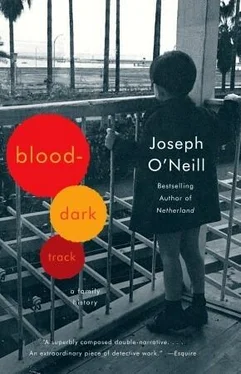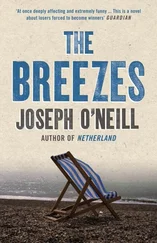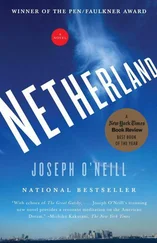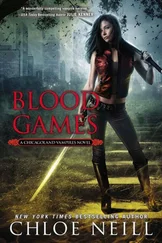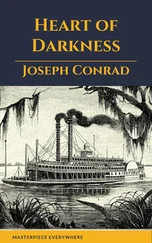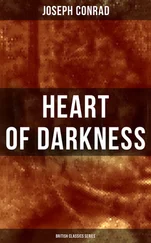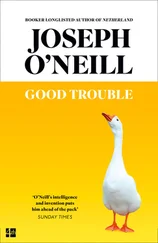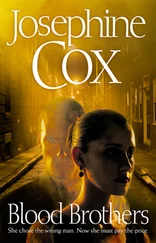We sat down in the front room, which had an unsurpassable view of the bay and a carpet that featured the same furiously swirling colours I’d seen in the farmhouses at Graunriagh and Ardkitt. Modest heirlooms furnished the room, and a painting by Sir Patrick’s father, Sir Egerton Coghill, Bt., hung on a wall. We continued chatting about the Coghills. Mrs Salter-Townshend said that the Coghill family home, Glenbarrahane, had been destroyed, which led to Grandma to chip in about the shameful neglect of old homes generally, which led to a discussion of the Georgian Society and, finally, of the unfortunate disappearance of Bowen’s Court, the ancestral home of the writer Elizabeth Bowen. One would never have guessed Grandma’s close connection to those who had so assiduously burned down Big Houses during the Anglo-Irish War. When Mrs Salter-Townshend momentarily turned away to pour tea, my grandmother gave me a conspiratorial wink that said, ‘You see, we’ve got her talking now.’
At this point it occurred to me that the conversation between the two old ladies — Mrs Salter-Townshend impatient, assertive and very kind, Grandma effusive and warm as ever — had a decidedly strange, even eerie, aspect: it was entirely possible that the cousin of the person serving the tea had been shot dead by the husband of the person drinking it. Feeling slightly compromised, I thought that the time had perhaps come to return to the subject of Admiral Somerville and disclose my interest in him. However, just as I was pondering precisely what the nature of that interest might be, our hostess rose and said that she’d an appointment and regrettably had to go. As we were accompanied to the door, Mrs Salter-Townshend handed me some brochures about properties in Castletownshend which she handled as agent for the owners. She said warmly to my grandmother, ‘Come by whenever you’re next here.’
We left the grounds of the Castle and started to walk back to the car, Grandma stepping tirelessly up the hill with the slightly rolling gait that practically all her sons have inherited. We got into the car and moved off. As we reached the two trees about a third of the way up the hill, I turned left down a lane called the Mall, which headed down towards the ocean. Immediately to our right, as we slowly descended, was the sizeable lodge house which was all that remained of the Coghill family property, Glenbarrahane, and which, one of Mrs Salter-Townshend’s brochures informed me, hosted in its roof space the largest known nursery of bats in Europe.
After the war, Sir Patrick Coghill, a little lost, spent a few years at this property with his elderly mother and aunt. In 1952, he left to set up the Special Branch of the Police of Jordan, from where he was expelled in 1956. He returned to Castletownshend and, he wrote in his autobiography, ‘to futility, to a bogus 18th century civilisation which was quite moribund, if not mummified, and what was worse, to boredom’. Furthermore, ‘having spent most of my life in England or serving the Crown, I intensely disliked living under the Irish Republican flag and government’. In the ’sixties, he finally decided to move across the water. Sir Patrick Somerville Coghill died in England in 1981, at the age of 84.
We reached the bottom of the lane. To our right was the entrance to Point House or, to be precise, The Point, as the property had been renamed by Admiral Somerville when he retired there after the Great War. ‘Do Not Enter’ notices were plastered everywhere.
Driving in, we found ourselves traversing an extraordinarily beautiful, tilted garden which ran down the landscaped contours of the hill by way of lawns, spectacular rock formations and exotic shrubbery; and looking out to the sunlit west, there was a dumb-foundingly beautiful view of a wild headland and the ocean. Then we came to the house. I recognized it from the newspaper photographs I’d seen. A late Victorian mansion of great simplicity, its charm was reduced only marginally by incongruous new window frames and a new entrance porch that stood in the place of the old porch where the Admiral’s corpse had lain for days pending the arrival of the pathologist. It was my intention to ring the bell and talk to whoever lived in the building — an Austrian countess, a villager had told me — about the terrible moment in the house’s past, and to try to find out if and how it still haunted the house. But I lost my nerve. It seemed a shame to mar the achieved quietness of this place with an old and unpleasant matter, and I allowed myself to conclude, without ringing the bell or even stopping the car, that no one was in. As we drove back to gate, gravel crunched under the car’s tyres just as, no doubt, it had crunched under the shoes of the men sprinting away from the house that night in March 1936. It was not a short driveway, a hundred yards or so, and the men, already breathless with terror and excitement, must have been gasping by the time they reached the car waiting at the gate. It wasn’t difficult, as we left Castletownshend, to imagine the country darkness into which the killers had sped, a shapeless obscurity of heaths and boglands and hills yielding only to the dull gaslight flare of an isolated cottage and the short track of light spewed out by the car.
We took an especially roundabout route back to Cork, heading north to Dunmanway, which, though she has not lived there for nearly seventy years, is my grandmother’s everlasting home town. Dunmanway marks the western extremity of the fertile Bandon valley, which constitutes an exception to the relatively poor land of which most of West Cork is composed. We drove along Main Street and arrived at a picturesque octagonal square. Grandma pointed out the location of the first home she remembered, which was now a vacant lot just off the square. The next Lynch home, in Railway Street, was still intact. The nearest thing to trees on the street were the tall wooden poles that strung cables over the rooftops and the road. My grandmother pointed out her old home, where she’d lived in terror of the British forces, a grey, two-storey terraced house that was part of a long, sullenly unadorned terrace of houses that ran the length of Railway Street under black roofs and gave abruptly on to the pavement without so much as a doorstep.
As we headed out of Dunmanway, Grandma pointed to a substantial townhouse. ‘That one,’ she said, ‘used to belong to Fitzmaurice, a solicitor, who fled Ireland after two men, Gray and Buttimer, were shot dead in Dunmanway square in 1921 during the Black and Tan War. After Fitzmaurice,’ Grandma said, ‘the house belonged to Henry Smith, a Protestant from the North with twenty-four children, who once gave shelter to your great-uncle Jack Lynch when he was on the run; and after the Smiths it was occupied by the Duffys, famous all over the country for their circus.’
I made a note of Grandma’s story that evening and did not give it any further thought; I vaguely assumed that Gray and Buttimer, in common with the other dead from those times mentioned by my grandmother, were the victims of yet another British atrocity.
We drove east along the Bandon valley and soon came to Ballineen and Enniskean, whose gradual physical merger over the years was acknowledged by a signboard announcing the Ballineen— Enniskean Development Area. We drove through Bandon town and then Inishannon, where the road, an unsightly and pot-holed strip of tarmac in my grandfather’s time, had been widened and smartened by EC money. Skimming along the new highway, we passed an ancient railway viaduct that hovered over a valley, and soon after crossed the boundary of Cork city, population 136,000, which declared itself a Nuclear Free Zone and a special friend of Cologne, Rennes, and Coventry. As we turned onto the new ring road that sped traffic efficiently into south-east Cork, I would not have been surprised to see, in this wave of up-beat redesignation, a sign announcing our presence in Emerald Tiger Country. Whereas uncle Brendan saw persistent poverty and social injustice and class struggle, it was possible to gain the impression from the mainstream media that the chief economic problem in Cork, in these unprecedented times of high growth and low inflation and net immigration and soaring property values, was finding sufficient numbers of takers for the vacancies (in high-technology work, especially) that were opening up in their hundreds. The old political and religious obsessions seemed further away than ever, and I asked my grandmother what she made of the changes taking place. It turned out that although she was proud of what had been achieved, Grandma was troubled by the emerging national character. She was worried, and a little amazed, by the sudden loss of authority of the Catholic church, which had become the source of a seemingly ever-flowing stream of sexual scandals and the butt of nihilistic TV comedies. ‘There is a God,’ Grandma said with an uncharacteristically anxious vehemence that made me glance over at her small, seat-belted figure, ‘as one day those that think there isn’t will find out to their cost.’ Grandma also didn’t understand the apathy amongst young people towards politics — ‘They say that they’re not “interested” in the elections. Sure, if you’re not interested in your country, what are you interested in?’ — and history: ‘A country is nothing without its history,’ my grandmother declared.
Читать дальше
Конец ознакомительного отрывка
Купить книгу
